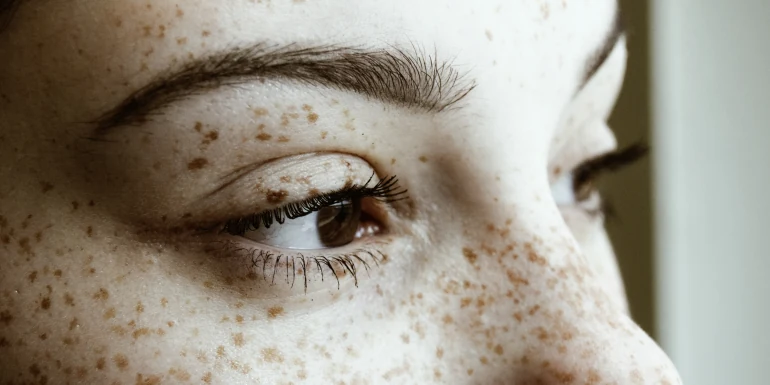
Conjunctivitis: symptoms, origin and treatment
Conjunctivitis can have various causes. Regardless of the reason, it should be treated right away. We’ll show you how to recognize conjunctivitis and how to manage it quickly with the right treatment.
Sometimes, it starts as a seemingly harmless itch or a light burning feeling. If your eye is slightly red and sticky, you most likely have conjunctivitis. The conjunctiva, as the foremost layer in the eye, is exposed to many pathogens that cause infections – and is therefore particularly sensitive. This is why conjunctivitis is the most common ailment affecting the human eye. It’s contagious and can be very uncomfortable. The good news: in most cases, conjunctivitis is harmless.
What is conjunctivitis?
The ultra-thin, crystal-clear mucous membrane that covers the front part of our eyeball and the inside of our eyelids is called the conjunctiva. Different outside influences can cause this sensitive film to become infected. It can be caused by a variety of factors and can develop into infectious conjunctivitis, allergic conjunctivitis, or as a result of external stimuli such as exposure to air or foreign objects.
Our health consultation advisors are happy to provide you with helpful information about different topics concerning the eyes, as well as tips for taking care of your eyes.
Conjunctivitis symptoms
The following symptoms may indicate conjunctivitis:
- A red, burning or itchy eye.
- Sensation of a foreign body in the eye
- Pressure in the eye
- Sticky eyelids on waking
- Light sensitivity
- Increased tear flow
- Swollen eyelids
The causes of conjunctivitis
Bacterial conjunctivitis
Bacterial conjunctivitis can occur in all age groups, but is more common in children than in adults. In this case, it is triggered by bacteria: Staphylococcus, Pneumococcus and Streptococcus. A typical feature of bacterial conjunctivitis is yellow discharge. Bacterial conjunctivitis often start in one eye, but can then spread to the other eye.
Viral conjunctivitis
Viruses such as adenoviruses or herpes simplex viruses can also cause conjunctivitis. In this case, the infection is usually recognised by a red, itchy eye. When adenoviruses trigger conjunctivitis, they are often accompanied by typical symptoms of the common cold: swollen lymph nodes, a runny nose or coughing. Conjunctivitis can also occur as a result of measles, rubella and chickenpox.
Whether bacterial or viral: both forms of conjunctivitis are contagious. It’s important, therefore, to follow proper hygiene standards. By doing so, you can avoid the spread of germs from one eye to the other and, especially, to other people. Wash your hands regularly, use a new hand towel daily (don’t share towels with other family members) and, if possible, stay home. Children should not go to kindergarten or school until their conjunctivitis has cleared up. The incubation period for infectious conjunctivitis – the time from infection to outbreak – is between five to twelve days, depending on the pathogen.
Non-infectious conjunctivitis
If neither bacteria nor viruses have triggered the conjunctivitis, it is called a non-infectious conjunctivitis. In this case, the causes are:
- Allergies (hay fever, allergic reactions to make-up, contact lenses, etc.)
- Foreign objects in the eye (dust, sand)
- Exposure to outside air
- UV-light
- Chlorine
In rare cases, improperly corrected defective vision can also trigger conjunctivitis. Find out more about the topics ‘short- and long-sightedness’ on our blog.
Treating conjunctivitis
When the eye is inflamed and irritated, the first step is to rest the eye: avoid computer screens, strong UV light and exposure to cold air. You can also alleviate some of the uncomfortable feeling of a foreign body in your eye by using artificial tear drops. However, since conjunctivitis can have different causes, treatment options are also very different.
Bacterial conjunctivitis
If the infection is caused by bacteria, it is generally treated with antibiotic creams or eye drops. In many cases, conjunctivitis heals within two to five days, even without antibiotics. However, antibiotic treatment shortens the healing process and helps prevent conjunctivitis from being passed to the other eye or to people in close proximity.
Be sure to avoid contact lenses if you have a bacterial conjunctivitis.
Viral conjunctivitis
If you have a viral infection, the only thing you can really do is wait until the infection heals on its own. In the meantime, you can alleviate your symptoms in the following ways:
- Relax your eyes with a cool compress
- Avoid contact lenses and eye makeup
- Keep your eyes moist with eye drops or eye cream
- Clean your eyes regularly with isotonic saline solution, then dry them immediately with cotton pads.
Be careful with home remedies
Home remedies may relieve the discomforts caused by conjunctivitis, but you should be careful when using them. Contrary to popular belief, you should not use chamomile if you have conjunctivitis: chamomile leaves have fine hairs that could actually cause additional itching within the eye and sometimes even trigger allergic reactions.
If you want to use medicinal plants to help the healing process, you can make an eye compress with black tea or eyebright (Euphrasia). Eyebright has a long history as a remedy for conjunctivitis and is also available in the form of eye drops.

The expert provided the editorial team with advice and input for this article. Julia Pieh (doctorate in pharmacy and toxicology, pharmacist, naturopath) works in the Helsana Health Consultation Service.

Newsletter
Find out more about current health issues every month and get all the information you need about our attractive offers from all Helsana Group companies * delivered by e-mail to read whenever it suits you. Our newsletter is free of charge and you can sign up here:
We did not receive your information. Please try again later.
* The Helsana Group comprises Helsana Insurance Company Ltd, Helsana Supplementary Insurances Ltd and Helsana Accidents Ltd.